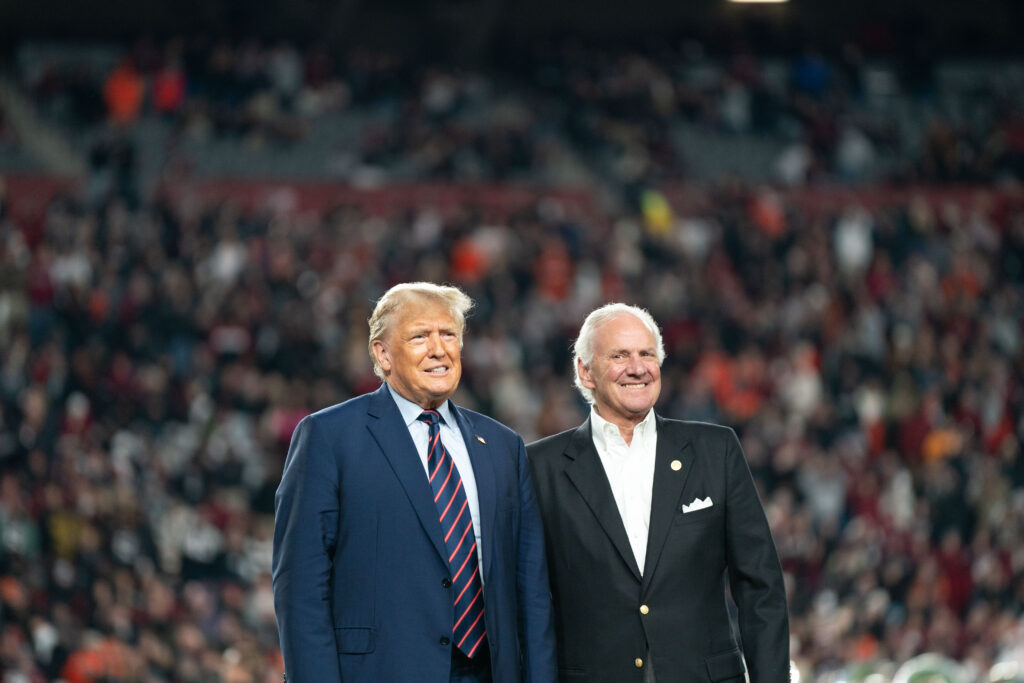
Former U.S. President Donald Trump joins South Carolina Gov. Henry McMaster on the field during halftime in the Palmetto Bowl between Clemson and South Carolina at Williams Brice Stadium on Nov. 25, 2023, in Columbia, South Carolina. (Photo by Sean Rayford/Getty Images)
Republican Donald Trump has easily won South Carolina, scooping up the state’s nine electoral votes in his third consecutive presidential contest.
As of 8:01 p.m., when The Associated Press made the call, the former president had 56% of the vote to Vice President Kamala Harris’ 38%, but with only 20 precincts reporting, according to unofficial results from state election officials.
The tallying continues nationwide in the race to reach the necessary 270 votes in the Electoral College.
Trump’s win in South Carolina was never in doubt. The big question was by how much. And, with vote-counting far from over, that’s still the question.
In 2020, he won the state by almost 12 percentage points over President Joe Biden. In 2016, he defeated Hillary Clinton here by more than 14 points.
The last time South Carolina voted to put a Democrat in the White House was 1976 for Jimmy Carter from neighboring Georgia.
Otherwise, it’s been a GOP streak since 1964 when South Carolinians voted for GOP Sen. Barry Goldwater over President Lyndon B. Johnson.
Trump’s 2016 win is what elevated then-Lt. Gov. Henry McMaster to the Governor’s Mansion. The GOP governor has been a staunch, unwavering supporter ever since.
It was McMaster’s early support of Trump that was rewarded.
McMaster was the first statewide official in the nation to back Trump for president ahead of the Palmetto State’s crucial first-in-the-South presidential nominating primary in February 2016, which Trump won. Nine months later, Trump picked then-Gov. Nikki Haley (who had backed other Republicans during the primary) as his United Nations ambassador, allowing McMaster to become governor.
This time, Haley opposed Trump directly with her own bid for the White House. What started as a crowded GOP field — with two Palmetto State candidates (Haley and U.S. Tim Scott) — narrowed after the Iowa caucuses to a two-person race between Trump and Haley.
The former president and former governor traded barbs across the state — on one occasion, Trump questioned the whereabouts of Haley’s husband, who was deployed at the time in Africa with the state National Guard. Haley said the question was disqualifying, as she called him a chicken for not debating her and questioned the mental acuity of both President Joe Biden and Trump.
As she campaigned, Haley said repeatedly that a vote for Biden was actually a vote to make Harris president. She turned out to be right, just not in the way she predicted.
Democrats made a big deal out of South Carolina hosting the nation’s first recognized presidential primary in February, escalating the state’s importance in the nomination process above its traditional first-in-the-South status.
Biden’s win was a given against two extremely long-shot candidates, but the party wanted to show enthusiasm for Biden in a diverse state. They arguably did, as he won with nearly 97% of the vote, though just 4% of registered voters turned out.
His showing in South Carolina ultimately didn’t mean much, as Biden withdrew in July and Harris became the nominee. It was the substitution of Harris, who made more campaign visits for Biden here than he did ahead of the primary, that ramped up enthusiasm among the Democratic base.
Three weeks after Biden won his primary, Haley lost her home state to Trump by more than 30 percentage points. But she stayed in, rejecting increased pressure in the Republican Party for her to drop out, until the day after Super Tuesday in March.
Haley declined to endorse Trump when she left the race, though she’s increasingly warmed to her former boss since.
In May, she confirmed in a public interview that she was voting for Trump, calling him a better alternative to the Democrat ticket. Then in July, she fully endorsed him at the Republican National Convention. And, just last week, she urged people rallying for a GOP U.S. Senate candidate in Pennsylvania to vote for Trump.
She has said she’s not interested in joining a second Trump administration. However, she made similar comments in 2016.
Whether that’s even a factor will be decided by voters in other states as the tallying to those 270 electoral votes continues.
This is a developing story. Check back for updates.

